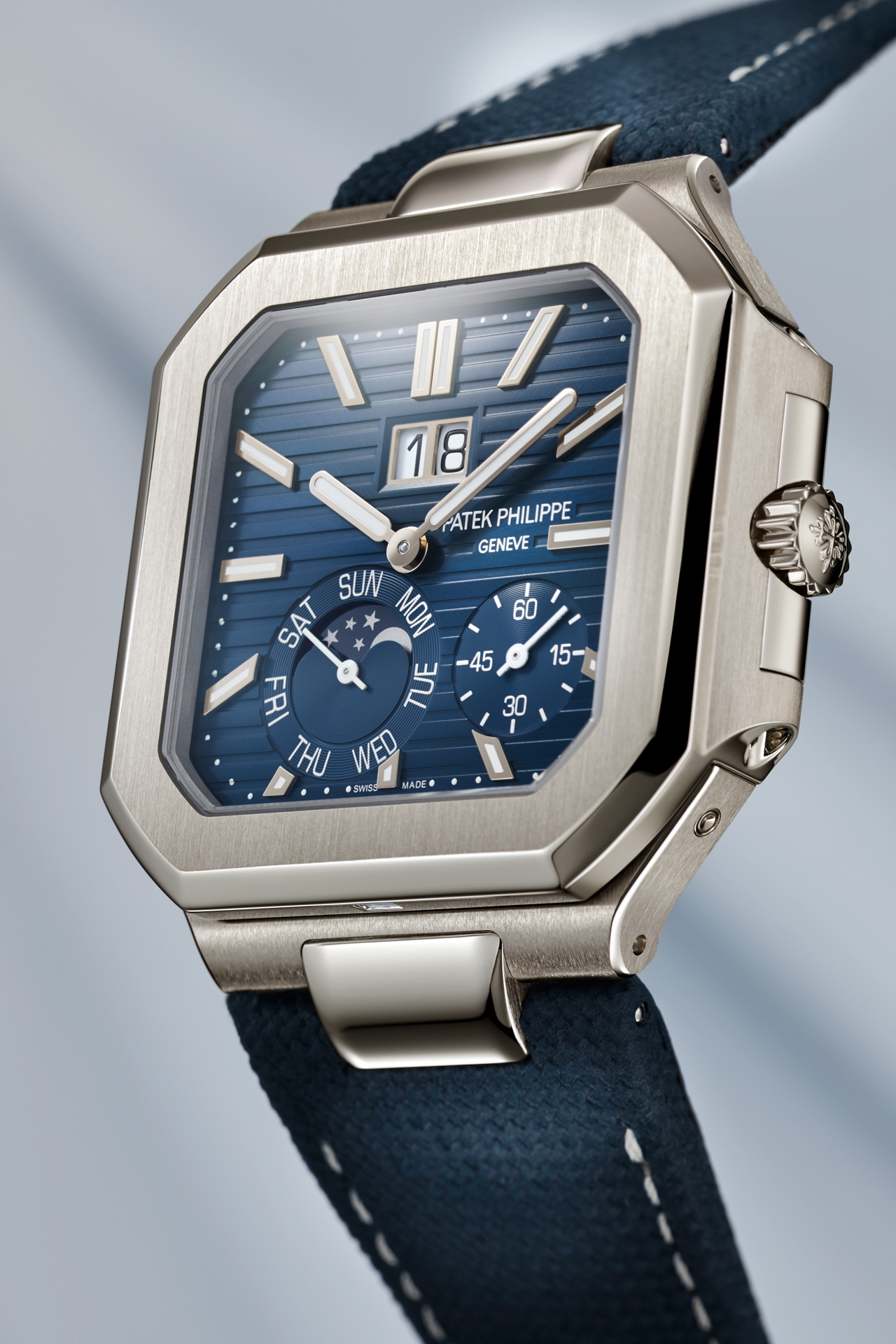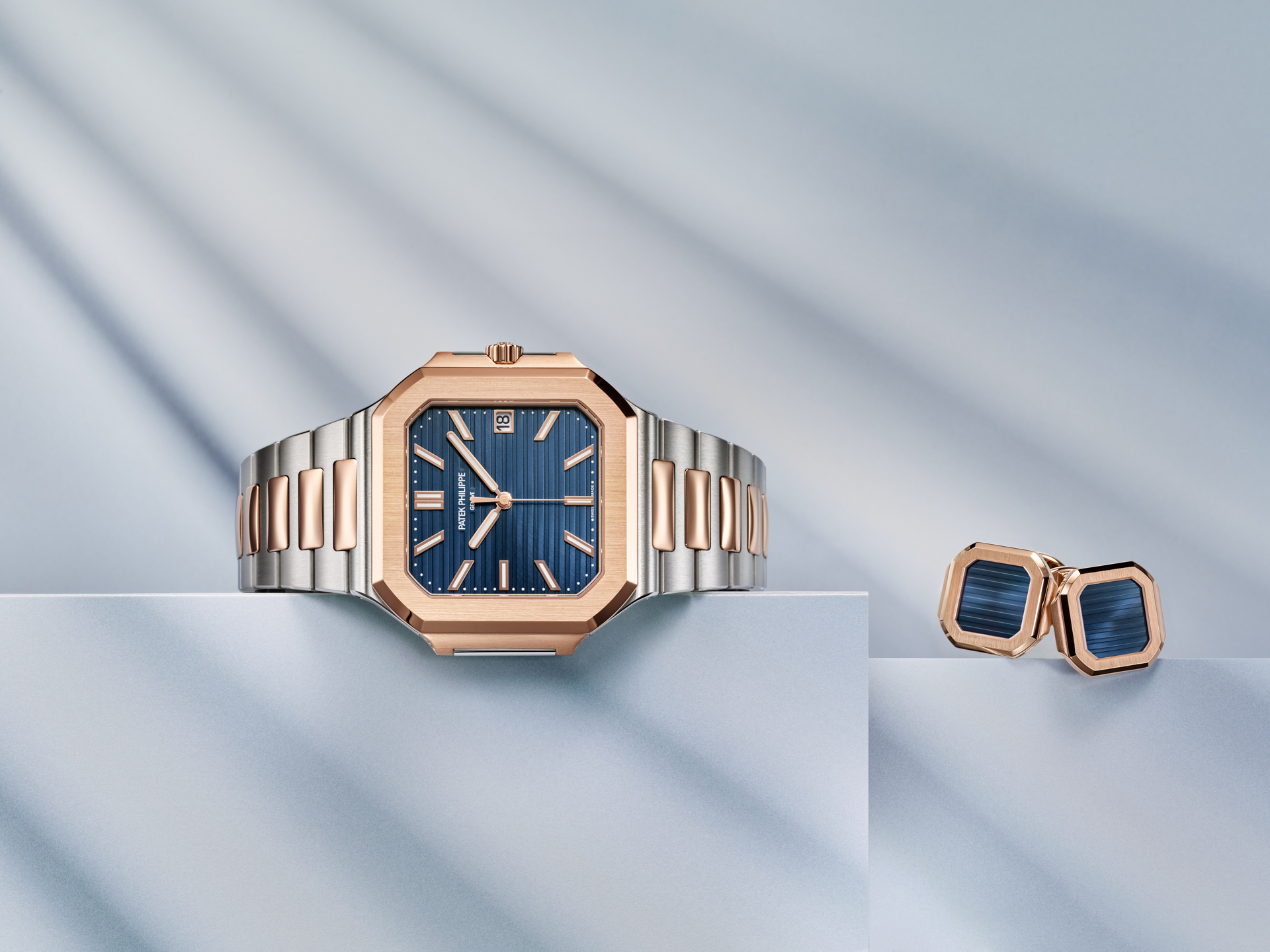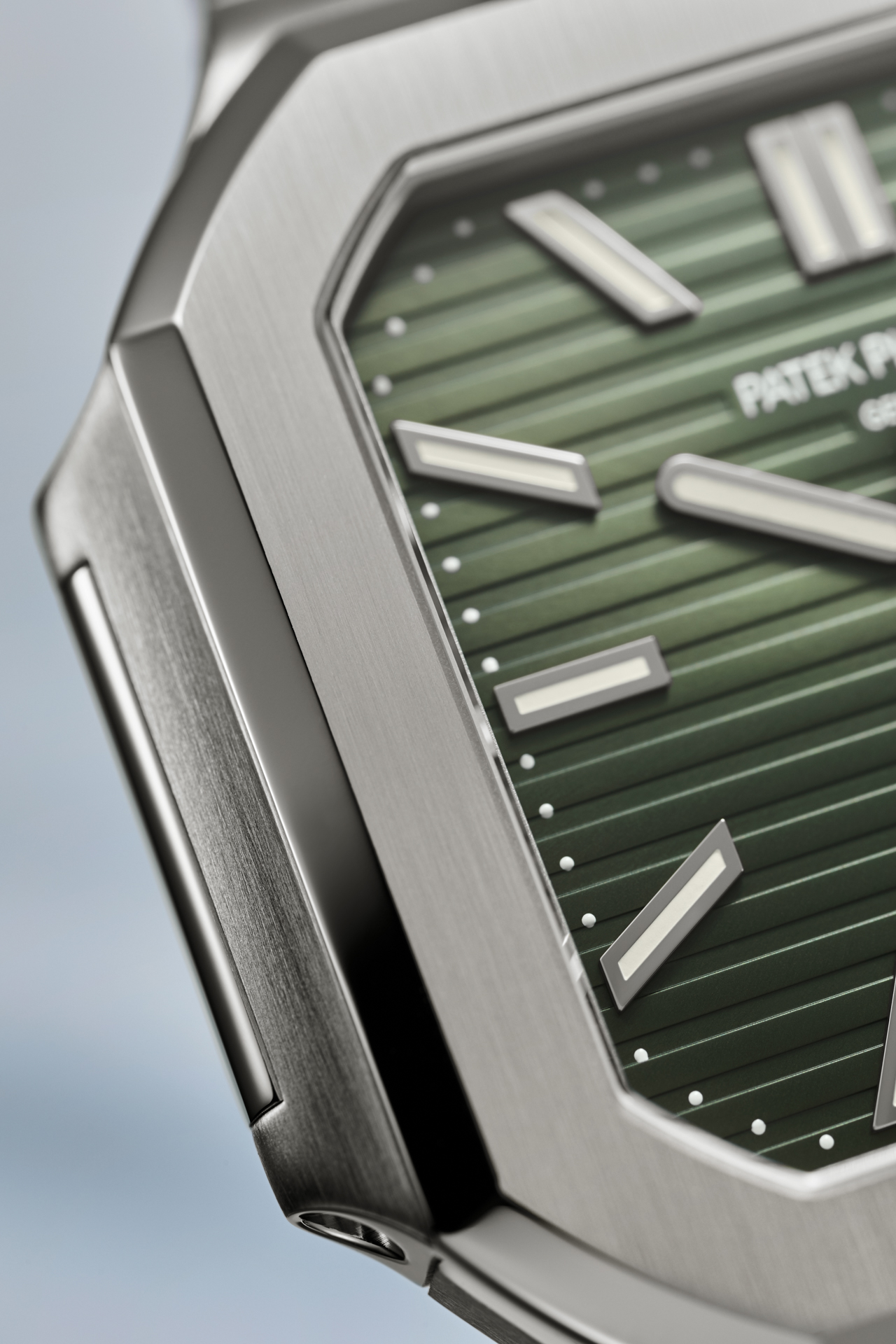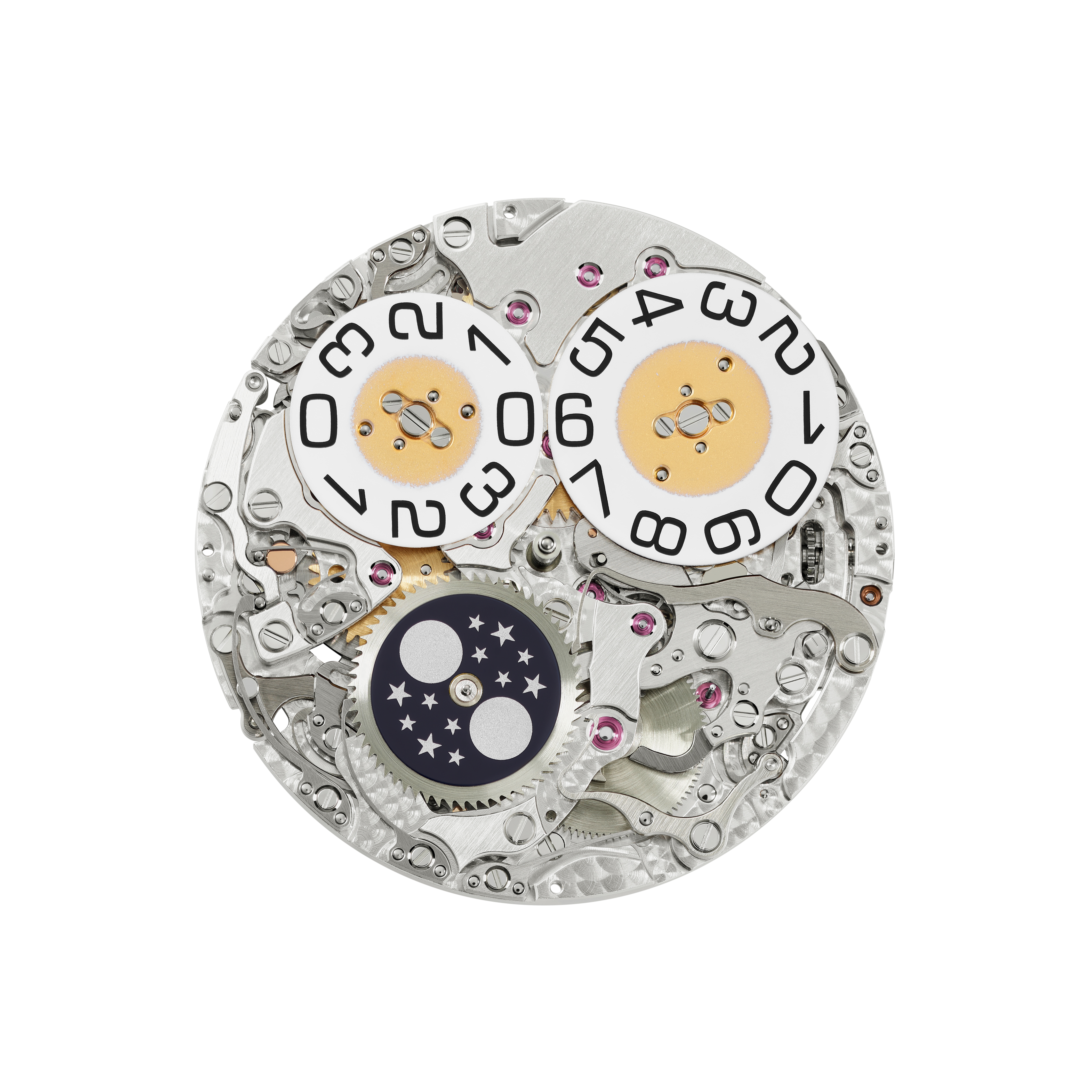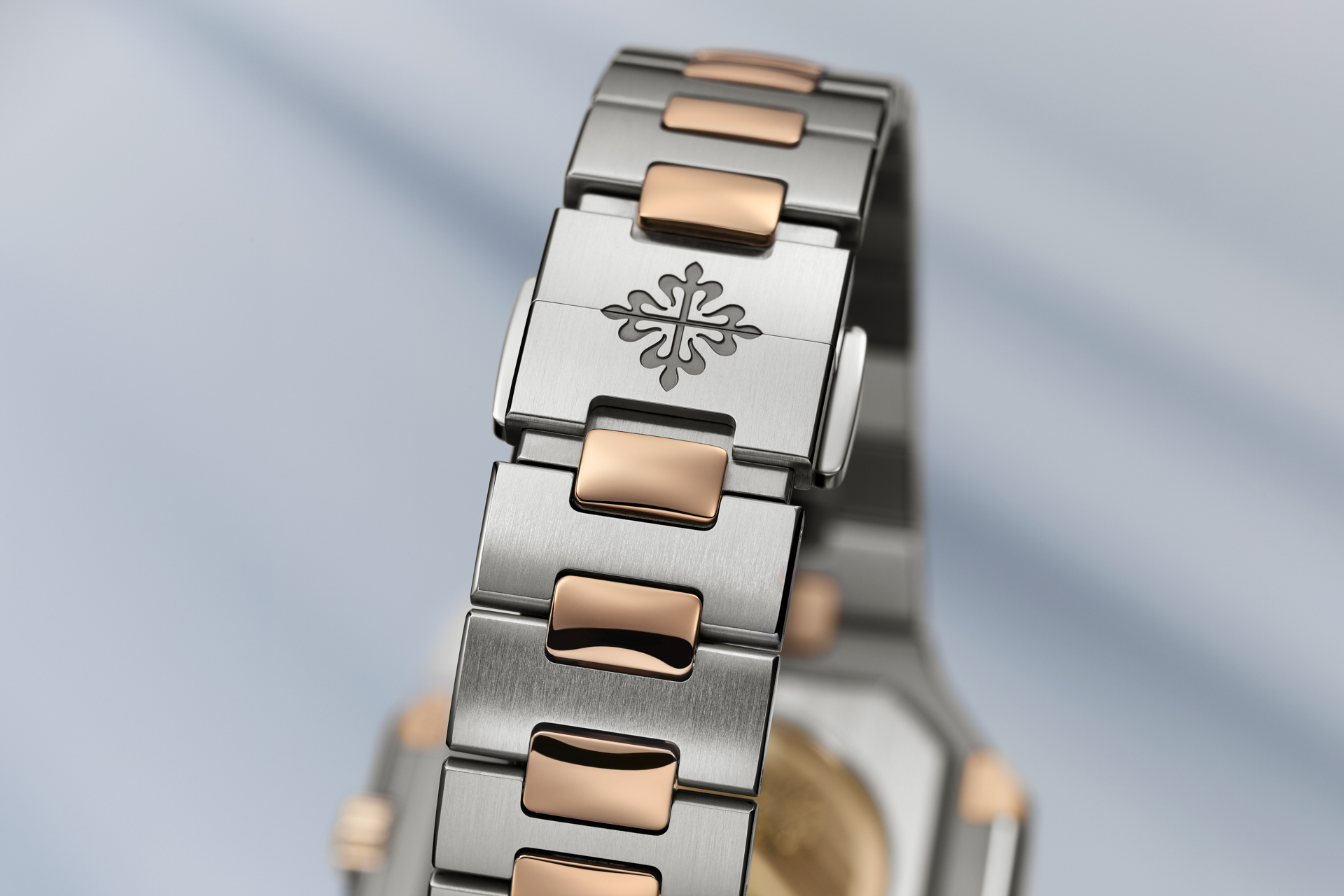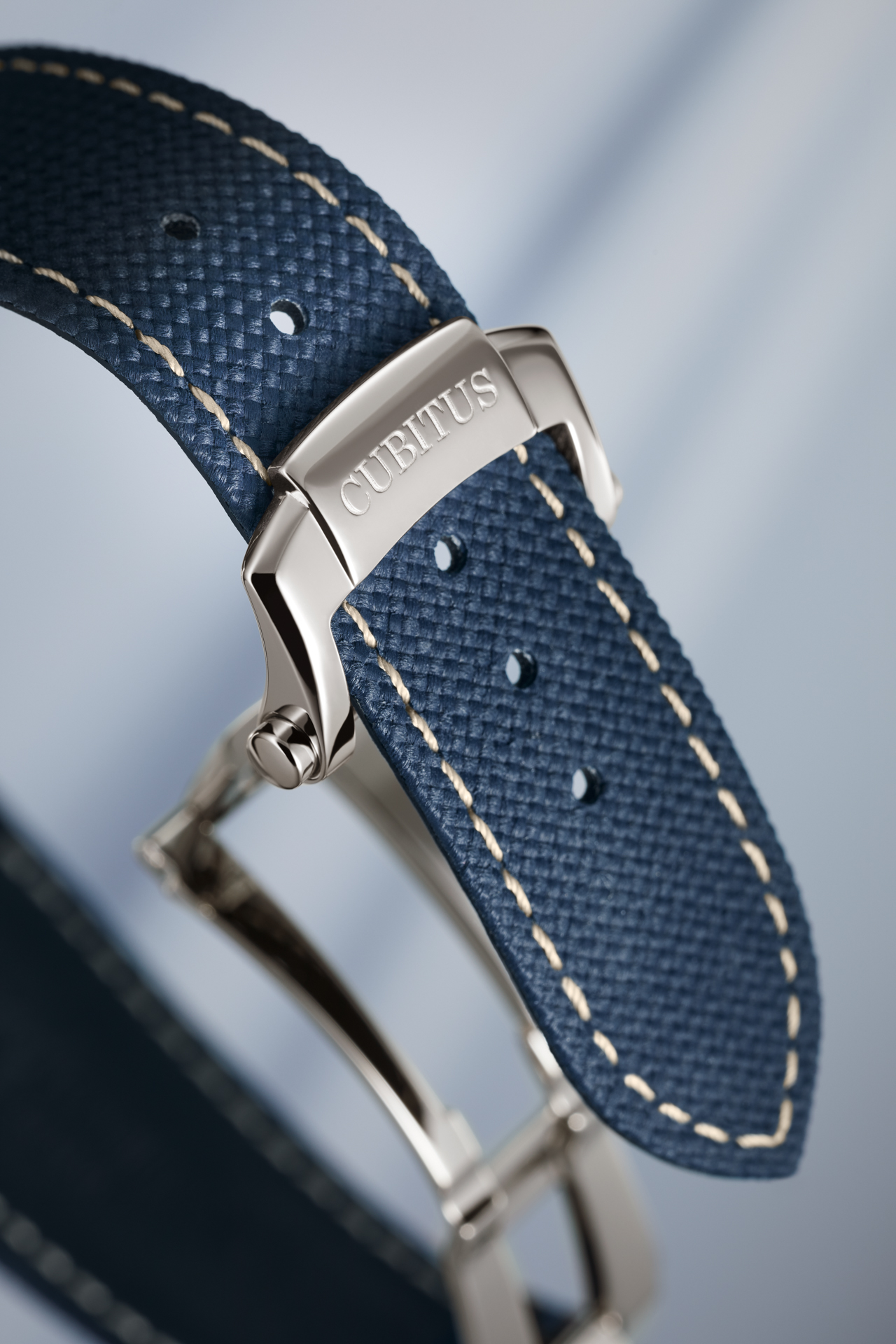Patek Philippe’s new square case watch, Cubitus, is the latest sensation in the watch industry, making waves since its first look - an ad featured in Forbes magazine - was leaked last week. Collector groups and forums have been buzzing because this is the first new release by the brand in 25 years, and is a sporty, unconventional square case design. There are three references in the Cubitus collection, which include two time and date models - Ref. 5821/1A-001 and Ref. 5821/1AR - and a grand date, day, and moonphase model - Ref. 5822P.
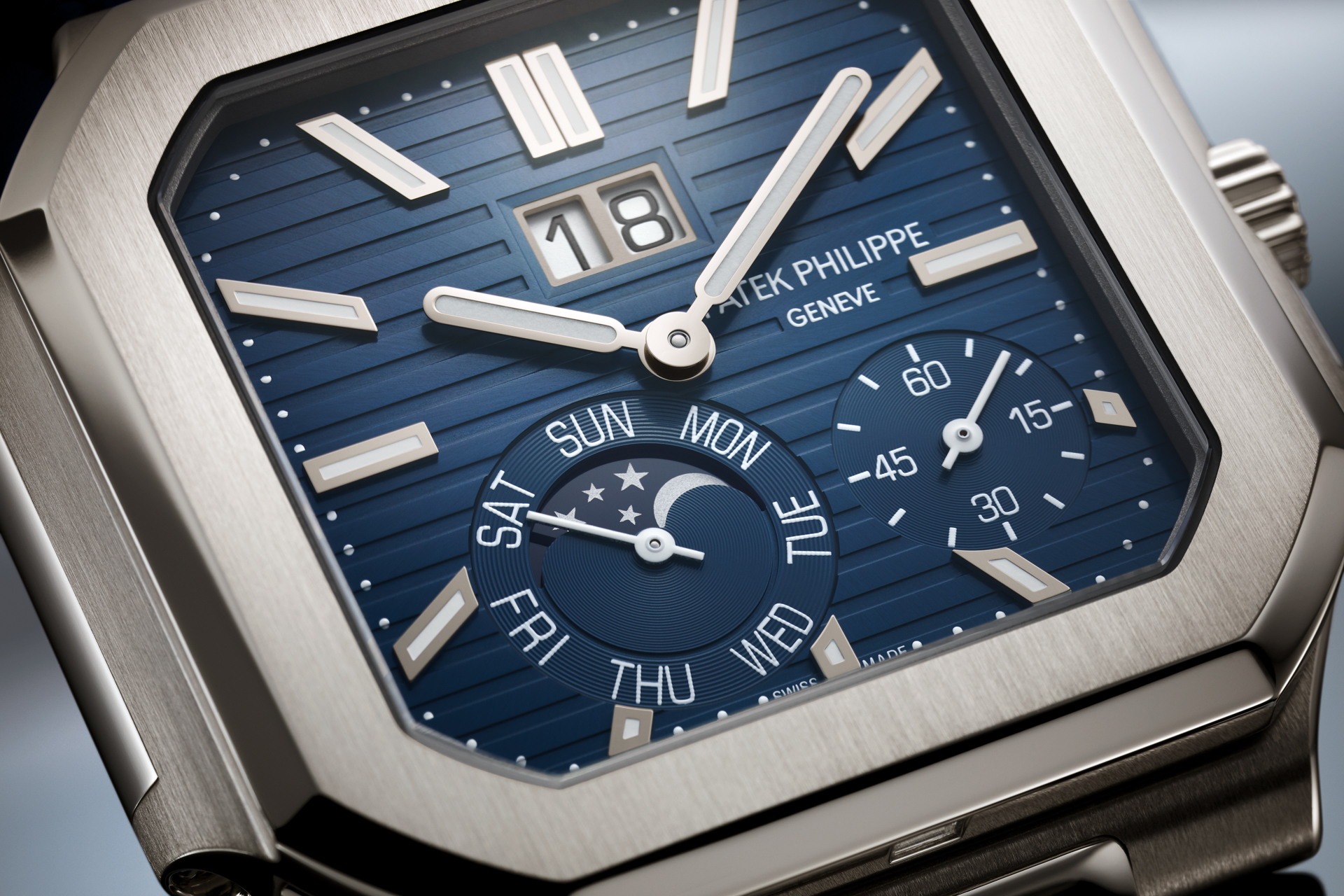 Patek Philippe Cubitus
Patek Philippe CubitusThe new square Cubitus complements the brand’s iconic lines such as the Nautilus, Aquanaut, Calatrava, Golden Ellipse, Gondolo and the ladies' watch Twenty-4, the last new collection introduced in 1999. As far as men's watches go, one has to go back two years more to the Aquanaut of 1997.
A new form
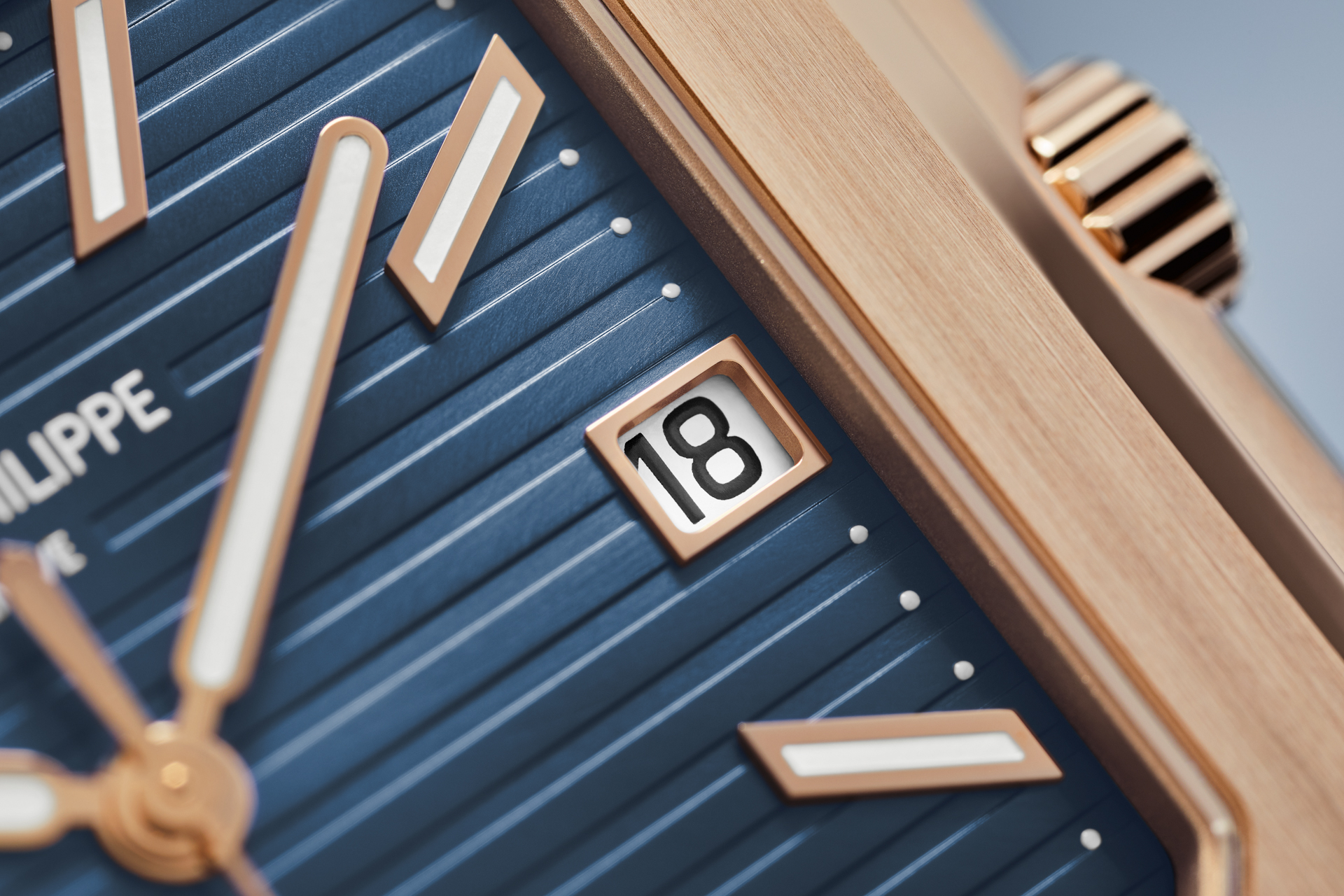 Patek Philippe Cubitus
Patek Philippe Cubitus
"I always wanted to have a square watch in the collection," says Thierry Stern, President of Patek Philippe. It wouldn’t be an exaggeration to say that 85 percent of watches today are round. In fact, you can count the number of square, especially square classics, on the fingers of one hand. It goes without saying then that when a brand like Patek Philippe brings out a shaped watch, it has to be something special. It has to surprise, maybe even polarize, but at the same time exude elegance and respect the brand's codes.
Patek Philippe has achieved this goal with Cubitus. The shape of the 45mm watch alone is cause for discussion, because even though Thierry Stern describes it as square, it could just as well be seen as an octagon. Patek Philippe's most sought-after watch, the Nautilus also has an octagonal bezel, but the edges are so rounded that they appear almost round (and there’s the embossed horizon relief on the Cubitus’s dial that’s reminiscent of the Nautilus). In contrast, the Cubitus, with its hard straight lines, offers clarity. Here, four long, equal-length straight lines take center stage, while the four short edges function as rounded corners. This ultimately creates the overall impression of a square.
The profile of the two-part case (the movement is encased from above) is quite flat - an explicit wish of Thierry Stern. Harmonious proportions and different surface finishes with vertical satin finish on the top of the bezel and polished edges evoke an overall sporty and elegant design.
Three models at launch
 Patek Philippe Cubitus Ref. 5821/1A, Ref. 5822P, and Ref. 5821/1AR
Patek Philippe Cubitus Ref. 5821/1A, Ref. 5822P, and Ref. 5821/1ARPatek Philippe is launching three models of the Cubitus. The focus is on the technically sophisticated Ref. 5822P-001 made of platinum, with a large date, small seconds, and the display of the day of the week and moon phases (more on this watch below).
The Ref. 5821/1AR-001 is a three-hand watch with date, made of stainless steel and rose gold with an integrated metal bracelet. While the bezel and the middle bracelet links are made of rose gold, the middle part of the case and the outer bracelet links are made of steel. Patek Philippe combines the bicolour design with a blue dial. The automatic Caliber 26-330 SC with central second hand, central rotor made of 21K gold and stop-seconds allows a low height of 8.3mm. The price of the watch is 60,257 euros.
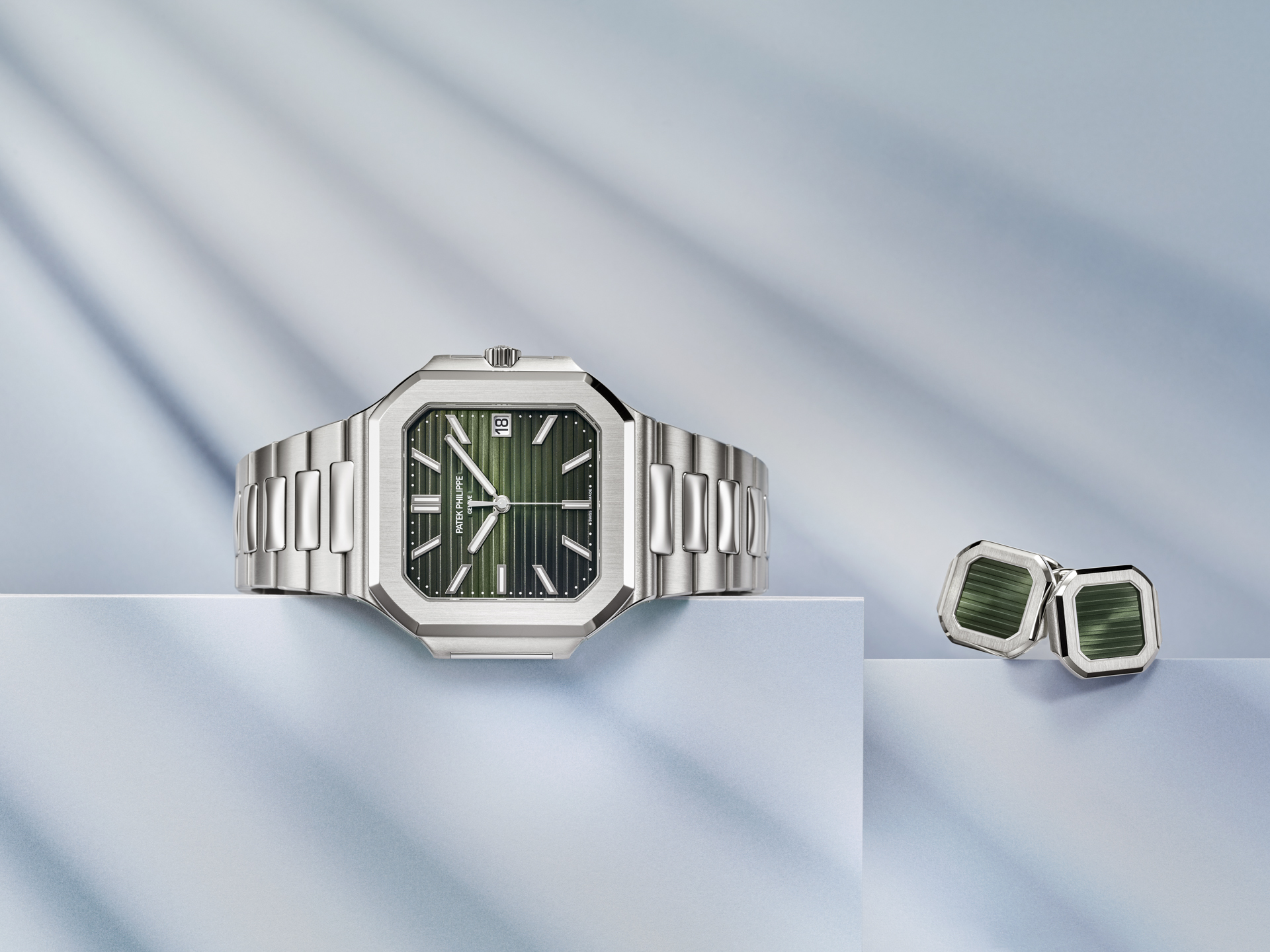 Patek Philippe Cubitus Ref. 5821/1A
Patek Philippe Cubitus Ref. 5821/1AThe Ref. 5821/1A-001 with a dark green dial is equipped with the same calibre and thus offers the same functions. The dimensions are also the same with a diameter of 45mm and a height of 8.3mm, as is the water resistance of 30 meters.
Both watches also have the date window at 3 o'clock and the shape of the baton hands in common. They are coated with a luminous material that glows white during the day and greenish in the dark. While the hands on the green watch are made of white gold, those on the bicolour version are made of rose gold. The steel link bracelet of the 5821/1A, like the bicolour bracelet of the 5821/1AR, has a lockable adjustment and a folding clasp patented by Patek Philippe with four independent fastening points. At a price of €40,557, it is the cheapest Cubitus.
The star of the line: Ref. 5822P
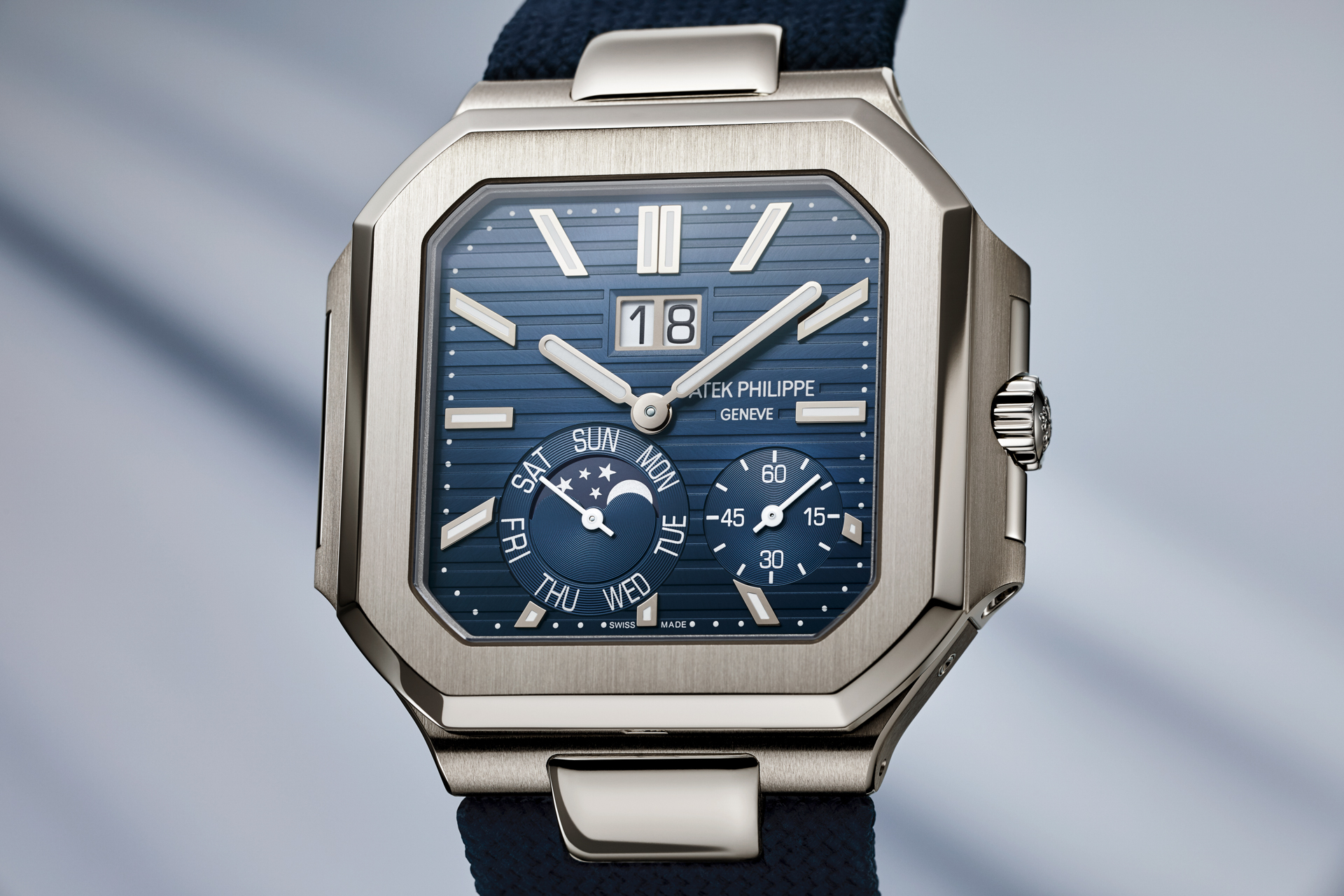 Patek Philippe Cubitus Ref. 5822P
Patek Philippe Cubitus Ref. 5822PRef. 5822P-001 is the undisputed star of the first three Cubitus models. It has three additional functions: Big date, day of the week, and moonphase , all of which jump together at midnight, instantly and simultaneously (to be precise, they are 18 milliseconds apart, which is impossible to see with the human eye).
Patek Philippe has developed the automatic Caliber 240 PS CI J LU with a micro-rotor, especially for the Cubitus. Anyone familiar with Patek will notice that the displays in the lower part of the dial are reminiscent of the Nautilus Ref. 5712. The small seconds at 4:30 and the sub-dial with the moonphase and date (instead of the day of the week) at 7 o'clock are in the same place. The background is that the Caliber 240 PS IRM C LU of the 5712 is also based on the automatic Caliber 240 developed in 1977 and the Patek development team led by Philippe Barat naturally drew on its experience with the movement of the Nautilus moonphase watch. The fact that the 240 was chosen was, on one hand, due to its flat design, and on the other hand, Patek Philippe puts it down to reliability and performance.
Large date: two discs on one level
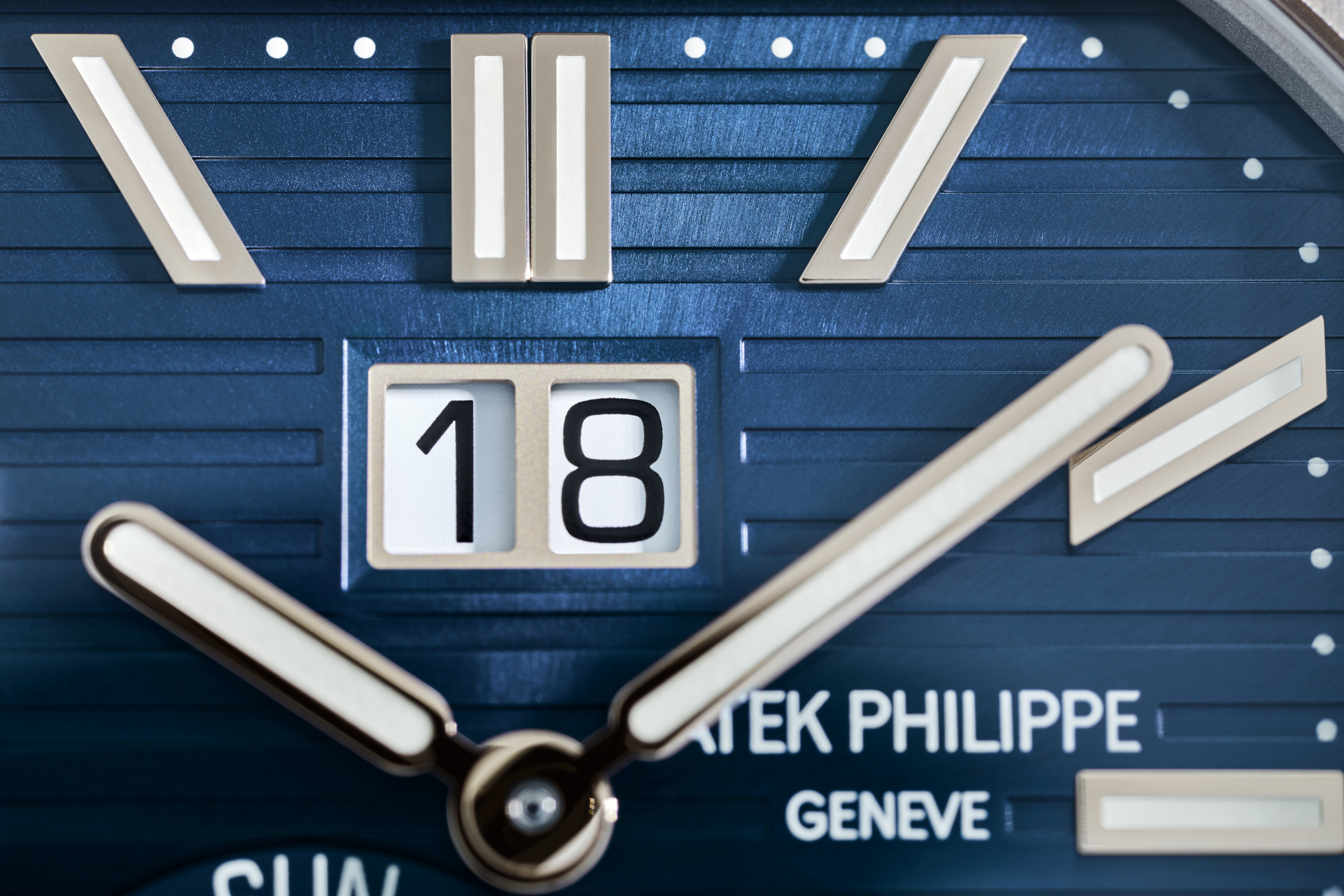 Patek Philippe Cubitus
Patek Philippe CubitusThe Cubitus is not the first Patek Philippe with a large date: There was the Ref. 5236, the perpetual calendar with the displays in one row. For aesthetic reasons, Patek only considered a large date in which the tens and units discs were on the same level. This requires a lot of power and the storage of sufficient energy. In addition, the date must, as described, jump in sync with the day of the week and the moonphase, and it must be guaranteed that the two digits are absolutely on the same line. All of these are complex requirements that were not easy to implement. Against this background, it is also understandable that the large date function alone required 104 additional components; without it, the new Caliber 240 PS CI J LU would have 104 additional individual parts compared to the 240 PS IRM C LU , making a total of 353 components. Nevertheless, at 4.76mm, it is only 0.77mm higher.
"I've always liked the square shape and I had a very specific one in mind. It shouldn't be too traditional, not too classic. It should be a bit sportier, waterproof and the design should also be suitable for younger people. But definitely as flat as possible,” says Thierry Stern, President, Patek Philippe.
Different types of jumps
A large date is not only larger and therefore easier to read, but also far more complex than a normal date. In particular, there are three different types of jumps: (1) the simple jump of the units disc, for example when changing from the 12th to the 13th of a month; (2) the additional tens jump, for example on the night of the 19th to the 20th; and (3) the jump from the 31st to the 1st, the only one where the units disc has to stop and only the tens disc moves. Thanks to wheels with cut teeth, Patek manages to keep the one digit stationary. And there is another feature, and a very important one: You can change the date at any time without damaging anything in the movement. This is remarkable in view of such complex technology, because there are far simpler date mechanisms that prohibit correction at certain times. Together with the features already mentioned, such as synchronized jumping and discs at the same height and numerals on one level, this results in a series of innovations for which Patek Philippe has registered a total of 6 patents.
But the 240 PS CI J LU can't do everything: The large date, moonphase, and day of the week cannot be corrected using the crown, but one has to use one of the three recessed correction buttons; a corresponding pin is included. As the watch is not an annual calendar, the date has to be corrected five times a year. In addition, it can only be adjusted in one direction, forwards. If you turn the time from 0.15 a.m. to 11.45 p.m., for example, the date does not go back, but stays the same.
Precision and power reserve
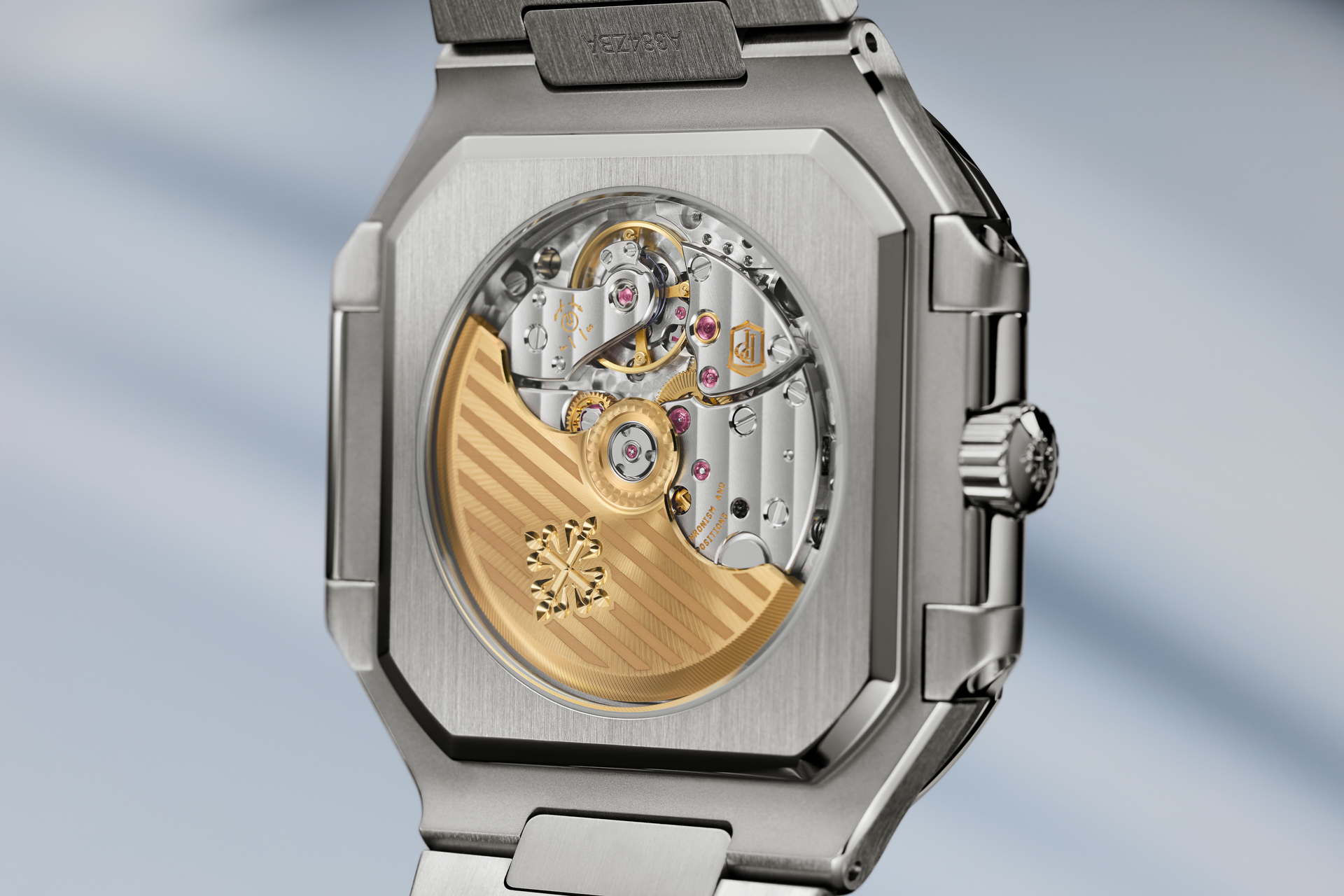 Movement of the Patek Philippe Cubitus
Movement of the Patek Philippe CubitusPatek specifies the power reserve of the Caliber 240 PS CI J LU as a minimum of 38 and a maximum of 48 hours - three hours more than the movement in the two Cubitus automatic models. While this seems to be in need of improvement, the value for the complication is satisfactory given the high power requirement. Aesthetically, the movement is, as always with Patek Philippe, a delight. Various decorative finishes such as perlage on the base plate, Geneva stripes on the bridges, and the horizontal decoration modeled on the dial make it a feast for the eyes that can be viewed through the sapphire crystal case back. The Patek Philippe seal is also engraved next to the brand name.
Material, strap and price
Like all platinum watches from Patek Philippe, the Cubitus Ref. 5822P is also discreetly decorated with a small diamond at 6 o'clock. This time, the Geneva manufacturer has made it baguette-cut for the first time. Unlike the automatic models, Patek does not offer the 5822P with a metal strap, as this would otherwise make the platinum watch very heavy on the arm. It is worn on a navy blue composite strap with a textile pattern and ecru-colored decorative stitching and a folding clasp. The price is €86,900.
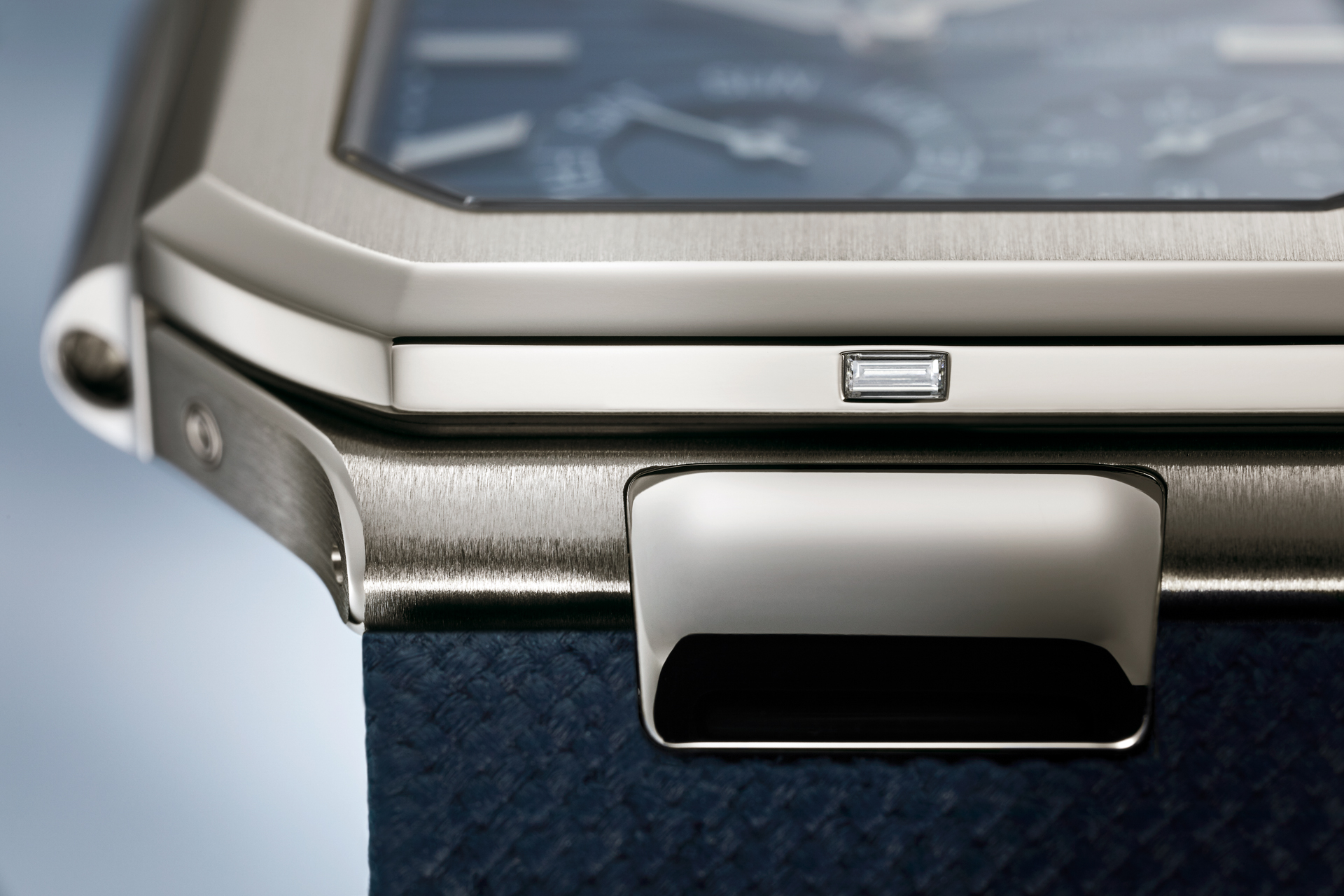 Diamond at six in the Platinum Patek Philippe Cubitus
Diamond at six in the Platinum Patek Philippe Cubitus
The name Cubitus
When Thierry Stern gave his people the task of developing a square watch, he already had the name ready: Cubitus. The word ‘cube’ is an allusion to the square shape, as a cube consists of six squares. And when spoken, Cubitus sounds similar to Nautilus, a relationship that we have already seen in the eight corners of the bezel and the horizontal relief embossing of the dial. The fact that ‘Cubitus’ is the anatomical term for the ulna (one of the two forearm bones) in Latin and French is more of a coincidence. But there is a connection there too, as the wrist on which you wear the watch is not that far from the ulna.
Conclusion
Patek Philippe has added a new chapter to the exciting topic of form watches. The square or octagonal shape, depending on how you look at it, is not everyone's cup of tea, but in the case of Patek, there is no need to worry about insufficient demand. Of course, the Cubitus will boom immediately after its launch, and there will be waiting lists - even if they will not be nearly as long as for the most popular Nautilus models. The Cubitus will polarize. But that is nothing new for Patek Philippe: The Calatrava Pilot Travel Time Ref. 5524 suffered a similar fate when it was launched in 2015 and of course the original Nautilus when it was first presented in 1976. Perhaps that is how it has to be when a brand like Patek Philippe launches a new line. But you should only form your opinion after you have held the watch in your hand. Only then will you see how finely crafted it is in every detail, and only then will you also feel the superior feel. Just adjusting the hands by turning the crown is an experience and is done so smoothly that it is rarely seen thanks to the type and use of the seals. It is precisely for such details, which are easily overlooked in the face of the abundance of other features, that luxury brands like Patek Philippe are loved.
Images: Courtesy brand


